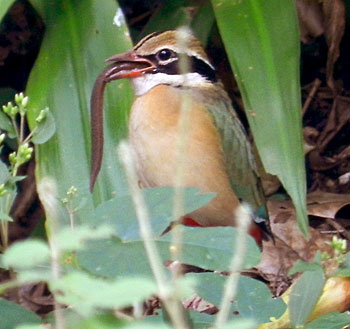


RECORDS OF A CEYLON WHISTLING THRUSH (Myophonus blighi) FEEDING ON A TREE FROG AND INTERESTING PREY OF TWO OTHER SPECIES, INDIAN PITTA (Pitta brachyura) & CRESTED HAWK-EAGLE (Spizaetus cirrhatus).
Tharanga Herath - CBCN February 2013 page 58 to 62
 The Ceylon Whistling Thrush is an endemic and endangered species (MOE 2012) which is very shy and elusive. It is most often seen between 3000-7000 feet elevation. It is regularly recorded from the Horton Plains National Park. Its shrill whistling call is heard (more often than the bird is seen) during dawn and dusk, during which times the species is apparently most active. Being a member of the thrush family its diet consists of insects as well as other small creatures including geckoes, lizards and frogs, usually captured from the ground.
The Ceylon Whistling Thrush is an endemic and endangered species (MOE 2012) which is very shy and elusive. It is most often seen between 3000-7000 feet elevation. It is regularly recorded from the Horton Plains National Park. Its shrill whistling call is heard (more often than the bird is seen) during dawn and dusk, during which times the species is apparently most active. Being a member of the thrush family its diet consists of insects as well as other small creatures including geckoes, lizards and frogs, usually captured from the ground.
The following is an observation of a pair trying to feed on an unusually large, well grown, Hourglass Mountain Frog Taruga eques.
On 15th February 2013 at the Horton Plains National Park I noticed a pair of Ceylon Whistling Thrush on the middle of the road by the “Arrenga Pool”. It was a cool misty morning around 0610 hours when light conditions were poor - an ideal setting for the Arrenga - an alternative name for the species - to come out.
Our vehicle which was the first to enter the park, stopped at a safe distance so as not to disturb the birds but allow further observation. Watching through my 8X32 binoculars under improving light conditions, I identified them as a pair of Ceylon Whistling Thrush, whereas earlier they appeared as two dark birds in the mist under poor light.
They appeared to be very interested in an object on the middle of the road and were either trying to devour it or carry it away. A few minutes later a vehicle passed along the road and the birds flew away but returned immediately after the vehicle left the site. The birds reappeared twice more after being disturbed by more vehicles. Ultimately they did not reappear, perhaps because the disturbances from passing vehicles was increasing and the light was also becoming brighter which was not to their liking.
Upon making certain the birds were not returning we walked up to their object of interest. We found it to be a gravid, female Hourglass Mountain Frog Taruga eques with a body measuring 2 inches though it was in fact much larger looking due to the long limbs. The frog was dying and we removed it from the middle of the road and placed it on the grassy verge, where we still found it three hours later, dead, on our return journey.
The Ceylon Whistling Thrush or Arrenga is a bird of about 8 inches in length, being a little bigger than a Red-vented Bulbul. However, it is sturdier than the latter, short tailed and has long, strong legs. All thrushes are said to be insectivores, while many eat fruits as well (Henry, 1971, 1998). Henry says “It feeds mainly on insects but does not despise small frogs, geckos, etc.; doubtless, it also partakes of fruit to some extent”.
The above-described prey can be considered unusual, as it was a large prey for a species of such size, and for a mainly insectivorous species. It is obvious that the birds could not swallow the prey whole, as many other birds usually do. These extremely shy birds showed their partiality to this particular prey, by their efforts to consume or carry it away under in spite of so much disturbance. Interestingly, Vincent Legge in his monumental work - ‘A History of the Birds of Ceylon’, in the account of the diet of this species states “Its food consists of various insects, Coleoptera, &c.; and in the stomach of my specimen I detected the bones of a frog, probably of the tree frequenting genus (Polypedatus)”. However there is no indication of the size of the prey of the gut content of the male specimen he procured in 1875 (Legge 1983). The latter genus is what has been renamed as Taruga, recently. The current observation helps to prove the Ceylon Whistling Thrush’s liking for Tree Frogs as well as their carnivorous nature in feeding behaviour. The Mountain Hourglass Tree Frog is restricted to the cloud forests in the central hills and their habitat is associated with water bodies (Manamendra-Arachchi & Pethiyagoda, 2006). Both the habitat and distribution are similar in both predator-prey species.
There is a possibility that there may have been a nest with nestlings since they returned despite being disturbed. If so, obviously the prey would have been torn to feed the young. Although it is doubtful, the breeding season for this species is said to be January to May as well as a secondary season of August-September (Henry, 1998).
Indian Pitta Pitta brachura feeding on a snake
The Indian Pitta (Pitta brachyura) is a migratory species that visits Sri Lanka regularly in the northern autumn-winter. It is endemic to the Indian subcontinent (Rasmussen & Anderton, 2005) and breeds in the Himalayan foothills and central India (Henry, 1998). After arrival it spreads throughout the country up to at least about 7,000 feet above mean sea level. It is a shy bird, being active early morning and evening in its habitat, which includes forest, scrubland, cultivated land (tea etc.) and well wooded home gardens. It is more often heard than seen as it makes its familiar “quite clear” note. It usually hops on the ground to find its prey by turning over leaves on the ground. Worms, insects - particularly termites, comprise its diet while it is partial to small snails (Henry, 1998). In addition, it picks up beetles, which it finds in the soil (Legge, 1983).
At the Victoria Park in Nuwara Eliya, I was able to observe an Indian Pitta feeding on a snake belonging to the genus Aspidura, which was about a foot long in length.
While bird watching with four others at the above location, I located an Indian Pitta by searching the undergrowth along the edge of the park. The bird was about 5metres from us, very quiet and well concealed. Subsequently I noticed its remarkably large prey. This was a large snake with its rear half hanging down from the bird’s beak, the anterior half having being swallowed. The bird became vary and slowly moved away but reappeared after about six minutes and came somewhat into the open just outside the hedge. I was able to take some photographs which are reproduced here.
We observed the bird for about 20 minutes during which time the bird was still not able to swallow its prey, though it did not give it up either.
The prey was identified as Common Roughside Aspidura trachyprocta by herpetologist Mendis Wickremasinghe by examining the images taken. Based on the length of the rear the snake, which was hanging from the bill, he stated that it could be about a foot (30cm) in length. This observation proves that the Indian Pitta feeds on such large prey, which is unusual for a mainly insectivorous small bird species.
Crested Hawk Eagle Spizaetus cirrhatus feeding on a young crocodile
Among the raptors found in Sri Lanka, the Crested Hawk-Eagle S. c. ceylanensis is a widespread taxon that occurs throughout the country. However it is mainly seen in low country dry zone areas, where it commonly occurs in parklands. It is one of the commonest raptors in Sri Lanka’s major National Parks located in the dry zone.
The prey of this eagle consists mainly of lizards, along with small rodents, and birds (Henry, 1998). In the literature on Sri Lankan birds, there are no records of Crested Hawk-Eagles feeding on young crocodiles.
On 5th January 2010, an individual of this species was seen feeding on a young crocodile. It was first noted by a safari driver and upon receiving this information, the site was visited by us. It was an open woodland area, where there was a small waterhole, in the Ruhunu National Park. The bird was a fully grown adult as evidenced by the well streaked breast. The bird alighted on a large branch of the tree, about 5m from the ground, holding its prey with his feet. The tail of the victim was visible from where our observations were made. There was a possibility that the crocodile was caught from the waterhole nearby. The prey, most probably a Mugger Crocodile Crocodylus palustris, the most likely to be seen species here among the two species found in Sri Lanka, was a young individual of approximately 0.5m in length. Furthermore the banded tail of juveniles as was seen is a characteristic of Mugger Crocodile rather than of the Saltwater Crocodile C. porosus (Das & De Silva, 2005).
Located in the low country dry zone of Sri Lanka, the Ruhunu National Park, holds large populations of both Crested Hawk-Eagles and Mugger Crocodiles Crocodylus palustris. The latter are attracted to the large number of waterholes as well as large flat areas of scrubland and forests. Therefore, young crocodiles can be a common prey for the eagles here.
Acknowledgements
I thank Mr. David Mower and party and Mrs. H. Miller who accompanied me during these observations, for their help given in the field. I am grateful to the safari driver who informed others of his sighting of the Hawk-Eagle and to Mr. Raj Kumar, the driver who took us to the Horton Plains National Park. Finally my gratitude goes to Mr. Mendis Wickremasinghe who shared his expert opinion on the prey of Indian Pitta, described here.
References:
Das, I and de Silva, A (2005); A Photographic Guide to the Snakes and other Reptiles of Sri Lanka, New Holland Publishers, U.K
Deraniyagala, P.E.P. (1955) a Colored Atlas of some vertebrates of Ceylon vol two & three, National Museum, Colombo
Harrison, J and Worfolk, T. (1999) A Field Guide to the Birds of Sri Lanka Oxford University Press, Oxford.
Henry, G. M. (1971) A Guide to the Birds of Ceylon 2nd Edition (1978), K.V.G de Silva & Sons, Kandy, Sri Lanka
Henry, G.M (1998); A Guide to the Birds of Sri Lanka 3rd Edition, Oxford University Press, Delhi
Herath, T (2010) In: Ceylon Bird Club Notes. pp 23